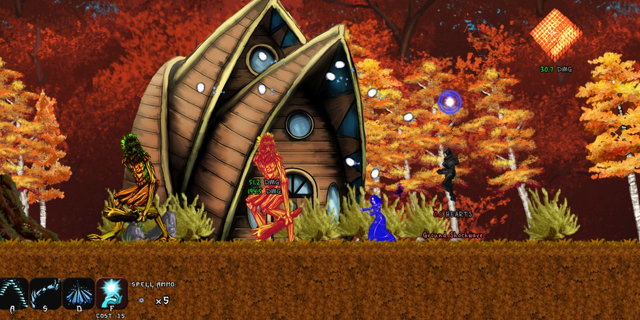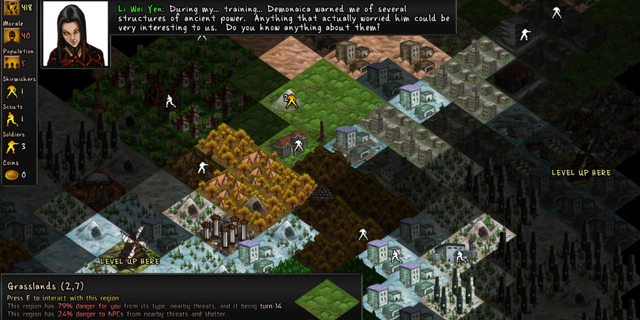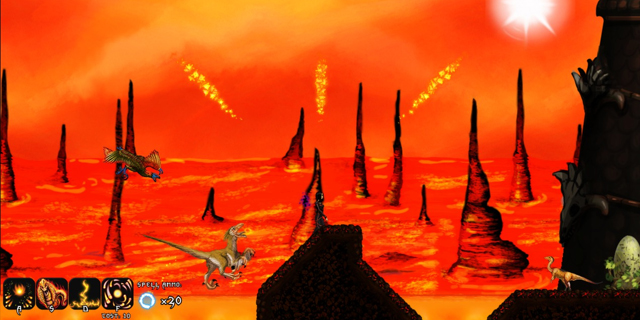
There will always be games that are more well-suited to one platform or another. Portable games designed for quick, pick-up-and-play action and collaboration. Console games are best-suited for a big screen and the simplicity of a controller. Computer games pride themselves on flexibility and depth. If a game designer can play to the advantages of a specific platform, experiences are lifted even higher by their platform of choice.
A Valley Without Wind 2 knows exactly what it wants to be, and carries out on the strengths of what it is. It is a game that exemplifies complexity, modularity and strategy in a way that few games have the guts to do. It is a truly fascinating work in its own right, and while it isn’t for everyone, it is an experience that every gamer should at least try.
The best way I can describe Valley 2‘s unorthodox gameplay is”ActRaiser meets Terraria“: the former because it adopts an overarching set of dual mechanics that separates gameplay between simulation city-building and side-scrolling platforming, and the latter because the game offers procedurally-generated overworld maps and levels. The 2D platforming segments have the same nuances about their feel: very floaty jumping controls, access to a good variety of abilities and an overall aesthetic evoking a lonely, yet awe-inspiring, reaction from the player.
Exploring the landscapes by yourself, troubled only by monsters whose movements feel more mechanical than aggressive, make for a somewhat sobering gameplay experience that allows the player time to reflect. For a game that offers so much complexity and depth, it has such a lax, calming pace.
It certainly benefits from it, as doing so does not burden the player with stressful decisions that must be made in more rapid succession. However, since the game chooses to introduce its myriad set of mechanics via uninteresting exposition dumps at given intervals. Granted, it’s better than front-loading the entire tutorial, but I feel that giving the player immediate firsthand interaction with the mechanics is necessary for a game of such complexity. Perhaps implementing a Civilization-esque counseling system would be beneficial, allowing the player to jump right in, while still learning new parts of the game only when necessary.

The game continues to show its computer gaming roots by giving the user a somewhat complicated and eccentric set of control schemes ,that make full use of the keyboard and mouse or whatever input device you may have. The game’s default settings have you using the arrow keys and QWER/ASDF keys, as well as some other outliers. Mouse aiming support has been added in as per the requests of fans, as it was the default option in the original Valley, and USB controllers are also supported. Ironically, after experimenting with various setups, I found the controller to be the best option, as Valley 2 seems more geared that way due to its default scheme. Either way, the controls have a steep learning curve, and while they are an apt reflection of the game’s depth, they are a daunting proposal to new players.
Character portraits and sprites, while borrowing some interesting and diverse ideas for character designs, are glossed over by uninspired generic fantasy artistic sensibilities, robbing the characters of any potential charm or memorable impact. The same goes for enemies, but to a slightly lesser extent, due to the fact that they can frequently branch out into stranger designs. Level embellishments and backgrounds, however, prove to be quite exquisite in their design, creating the aforementioned sense of isolation and eerie calmness that makes the gameplay unique.
Since the game’s levels are randomly generated, these elements are never placed in the forefront or used in any deliberate way. They generally match well with the location, and even hint towards unspoken parts of the narrative to clue the player into the intricacies of Valley 2’s world, which I always applaud when done correctly. The audio presentation does the same, lulling the player into a state of mesmerization and peace. However, because of this fact that the music serves a utilitarian function, none of the tracks are particularly memorable.
A Valley Without Wind 2 is the ideal game for any gamer who can get lost in a world. If you have pulled one too many all-nighters playing an Elder Scrolls game or Minecraft, then this is probably the game for you, provided you can get past the somewhat-questionable artistic direction. It is a game that is endemic of the virtues embodied by computer gaming as a whole, and wears this design mentality as a badge of honor.



















